Front brake - all models
1. Each brake pad has wear indicators in the form of cutouts in the top and bottom edges of the friction material; these cutouts should be visible by looking at the edges of the friction material from above or below the caliper body. On early XL600V models, a cast arrowhead in the top of the caliper body indicates where to view the pad material.The pads also have wear indicator grooves cut in the face of the friction material which will be visible by sighting along the disc surface to the side of the pad (see illustration).
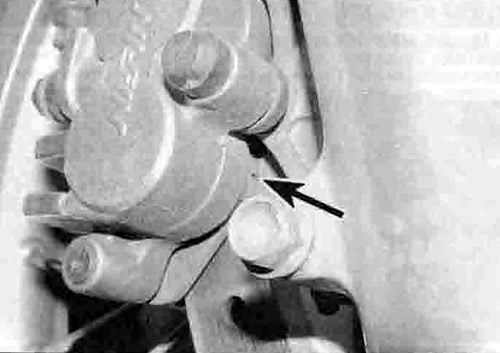
3.1. Brake pad wear indicator groove (arrowed)
2. If the wear indicators aren't visible due to an accumulation of road dirt and brake dust, or there is any doubt as to how much friction material is left, the pads should be removed from the caliper for closer inspection (see illustration) as described in Chapter 7, Section 2.
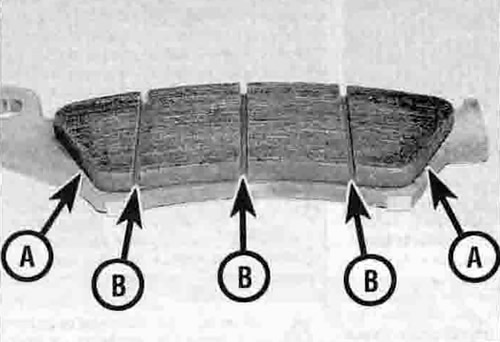
3.2. Front brake pad wear indicator cutouts (A) and grooves (B) - pad removed
3. If the friction material on any pad has worn down to expose the wear cutouts, or down level with the base of the grooves, the pads are worn and must be renewed, although it is advisable to renew the pads before they become this worn.
Note: Some after-market pads may use different wear indicators to those supplied as original equipment.
4. Honda do not specify a minimum thickness for the brake pad friction material, but anything less than 1 mm should be considered worn. If the pads are excessively worn, check the brake disc(s) (see Chapter 7, Section 3). Note that the brake pads must be renewed as a pair. On models with twin front discs, both sets of pads in each front caliper should be renewed at the same time.
Rear brake
Rear drum brake - XL600V-H to L (1987 to 1990) models
5. The rear brake has a wear indicator to determine the amount of wear in the brake shoe friction material. The wear indicator is in the form of a pointer which moves with the brake arm when the pedal is applied. If, on full application of the brake pedal, the pointer aligns with the triangular reference mark on the brake plate the shoes are worn and must be replaced with new ones (see illustration).
the form of a pointer which moves with the brake arm when the pedal is applied. If, on full application of the brake pedal, the pointer aligns with the triangular reference mark on the brake plate the shoes are worn and must be replaced with new ones (see illustration).
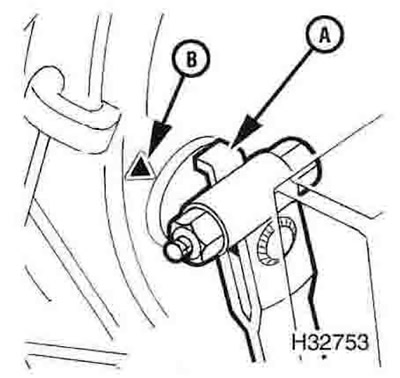
3.5. Rear brake shoe wear indicator pointer (A) and triangular reference mark on brake plate (B)
6. If you are in doubt as to the amount of friction material remaining, remove the brake plate and measure the thickness of the friction material on the shoes (see Chapter 7, Section 2). Honda specify a minimum thickness of 2 mm for the friction material. If the shoes are excessively worn they must be renewed as a pair
7. If the shoes are renewed, also check the condition of the brake drum surface as described in Chapter 7, Section 3.
Rear disc brake - all models except the XL600V-H to L
8. Each brake pad has a wear indicator In the friction material which is in the form of a scribed line around the periphery. The wear indicators should be plainly visible by looking at the edges of the friction material from the rear edge of the pad from behind the caliper (see illustration). If the indicators aren't visible due to an accumulation of road dirt and brake dust, or there is any doubt as to how much friction material is left, the pads should be removed from the caliper for closer inspection (see illustration) as described in Chapter 7, Section 2.
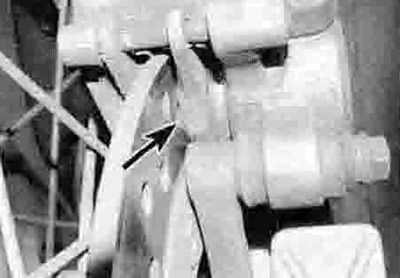
3.8a. View the rear brake pads (arrowed) from the rear of the caliper
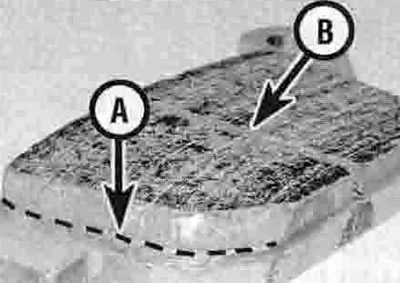
3.8b. Brake pad wear indicator line (A) and groove (B)
9. If the friction material on either pad has worn down to the wear limit line, the pads are worn and must be renewed, although it is advisable to renew the pads before they become this worn.
Note: Some after-market pads may use different wear indicators to those supplied as original equipment.
10. Honda do not specify a minimum thickness for the brake pad friction material, but anything less than 1 mm should be considered worn. If the pads are excessively worn, check the brake disc (see Chapter 7, Section 3).
11. The brake pads must be renewed as a pair.
